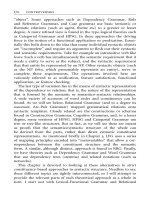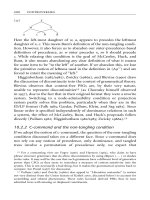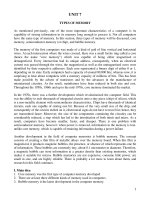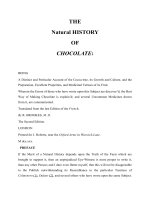STRUCTURE OF EARTH docx
Bạn đang xem bản rút gọn của tài liệu. Xem và tải ngay bản đầy đủ của tài liệu tại đây (179.29 KB, 10 trang )
STRUCTURE OF EARTH
The interior structure of the earth is layered in spherical shells, like
an pears. Earth has an outer silicate solid crust , a highly viscous
mantle, a liquid outer core that is much less viscous than the mantle,
and a solid inner core .The structure of the Earth can be determined in
two ways, including mechanical or chemical properties such as
rheology. Mechanically, we divided it into five layers, including the
lithosphere, the atmosphere soft, middle coating, outer core, and inner
core. On the chemical side, we split it into the crust, upper mantle,
lower crust mantle, outer core and inner core.
I.Crust
The crust of the Earth is composed of a great variety
ofigneous, metamorphic, and sedimentary rocks. The crust is underlain
by the mantle. The upper part of the mantle is composed mostly
of peridotite, a rock denser than rocks common in the overlying crust.
The boundary between the crust and mantle is conventionally placed at
the Mohorovičić discontinuity, a boundary defined by a contrast
in seismic velocity. The crust occupies less than 1% of Earth's volume.
The oceanic crust of the sheet is different from its continental crust. The
oceanic crust is 5 km (3 mi) to 10 km (6 mi) thick and is composed
primarily of basalt, diabase, and gabbro. The continental crust is
typically from 30 km (20 mi) to 50 km (30 mi) thick and is mostly
composed of slightly less dense rocks than those of the oceanic crust.
Some of these less dense rocks, such as granite, are common in the
continental crust but rare to absent in the oceanic crust. Both the
continental and oceanic crust "float" on the mantle. Because the
continental crust is thicker, it extends both above and below the oceanic
crust. The slightly lighter density of felsic continental rock compared to
basaltic ocean rock contributes to the higher relative elevation of the top
of the continental crust. Because the top of the continental crust is above
that of the oceanic, water runs off the continents and collects above the
oceanic crust. The continental crust and the oceanic crust are sometimes
called sial and sima respectively. Because of the change in velocity
of seismic waves it is believed that on continents at a certain depth sial
becomes close in its physical properties to sima, and the dividing line is
called the Conrad discontinuity.
The temperature of the crust increases with depth, reaching values
typically in the range from about 200 °C (392 °F) to 400 °C (752 °F)at
the boundary with the underlying mantle. The crust and underlying
relatively rigid uppermost mantle make up the lithosphere. Because
of convection in the underlying plastic (although non-molten) upper
mantle and asthenosphere, the lithosphere is broken intotectonic
plates that move. The temperature increases by as much as 30 °C (about
50 °F) for every kilometer locally in the upper part of the crust, but
the geothermal gradient is smaller in deeper crust
Partly by analogy to what is known about our Moon, Earth is considered
to have differentiated from an aggregate of planetesimals into its core,
mantle and crust within about 100 million years of the formation of the
planet, 4.6 billion years ago. The primordial crust was very thin and was
probably recycled by much more vigorous plate tectonics and destroyed
by significant asteroid impacts, which were much more common in the
early stages of the solar system.
The Earth has probably always had some form of basaltic crust, but the
age of the oldest oceanic crust today is only about 200 million years. In
contrast, the bulk of the continental crust is much older. The oldest
continental crustal rocks on Earth have ages in the range from about 3.7
to 4.28 billion years and have been found in the Narryer Gneiss
Terrane in Western Australia, in the Acasta Gneiss in theNorthwest
Territories on the Canadian Shield, and on other cratonic regions such as
those on the Fennoscandian Shield. Some zirconwith age as great as 4.3
billion years has been found in the Narryer Gneiss Terrane.
The average age of the current Earth's continental crust has been
estimated to be about 2.0 billion years. Most crustal rocks formed before
2.5 billion years ago are located in cratons. Such old continental crust
and the underlying mantle asthenosphere are less dense than elsewhere
in the earth and so are not readily destroyed by subduction. Formation of
new continental crust is linked to periods of intense orogeny; these
periods coincide with the formation of the supercontinents such
as Rodinia, Pangaea and Gondwana. The crust forms in part by
aggregation of island arcs including granite and metamorphic fold belts,
and it is preserved in part by depletion of the underlying mantle to form
buoyant lithospheric mantle.
Oceanic crust is the part of Earth's lithosphere that surfaces in
the oceanbasins. Oceanic crust is primarily composed of mafic rocks,
or sima, which is rich in iron and magnesium. It is thinner
than continental crust, or sial, generally less than 10 kilometers thick,
however it is denser, having a mean density of about 2.9 grams per cubic
centimeter
[1]
as opposed to Continental which has a density of about 2.7
grams per cubic centimeter.
The continental crust is the layer of igneous, sedimentary,
andmetamorphic rocks which forms the continents and the areas of
shallow seabed close to their shores, known as continental shelves. This
layer is sometimes called sial because there is more felsic, orgranitic,
bulk composition, which lies in contrast to the oceanic crust,
called sima because of the mafic or basaltic rock. (Based on the change
in velocity of seismic waves, it is believed that at a certain depth sial
becomes close in its physical properties to sima. This line is called
the Conrad discontinuity.)
Consisting mostly of granitic rock, continental crust has a density of
about 2.7 g/cm
3
and is less dense than the material of the
Earth'smantle (density of about 3.3 g/cm
3
), which consists of mafic rock.
Continental crust is also less dense than oceanic crust (density of about
2.9 g/cm
3
), though it is considerably thicker; mostly 25 to 70 km versus
the average oceanic thickness of around 7–10 km. About 40% of the
Earth's surface is now overlaid by continental crust. Continental crust
makes up about 70% of the volume of Earth's crust
II. Mantle
The mantle is a part of a terrestrial planet or other rocky body large
enough to have differentiation by density. The interior of the Earth,
similar to the other terrestrial planets, is chemically divided into layers.
The mantle is a highly viscous layer between the crust and theouter core.
Earth's mantle is a rocky shell about 2,900 km (1,800 mi) thick that
constitutes about 84% of Earth's volume.It is predominantly solid and
encloses the iron-rich hot core, which occupies about 15% of Earth's
volume.Past episodes of melting and volcanism at the shallower levels
of the mantle have produced a thin crust of crystallized melt products
near the surface, upon which we live.Information about structure and
composition of the mantle either result from geophysical investigation or
from direct geoscientific analyses on Earth mantle derived xenoliths.
Two main zones are distinguished in the upper mantle: the
innerasthenosphere composed of plastic flowing rock about 200 km
thick, and the lowermost part of the lithosphere composed of rigid rock
about 50 to 120 km thick. A thin crust, the upper part of the lithosphere,
surrounds the mantle and is about 5 to 75 km thick.
In some places under the ocean the mantle is actually exposed on the
surface of the Earth.There are also a few places on land where mantle
rock has been pushed to the surface by tectonic activity, most notably the
Tablelands region of Gros Morne National Park in
the Canadian province of Newfoundland and Labrador.
The mantle is divided into sections which are based upon results
from seismology. These layers (and their depths) are the following: the
upper mantle (starting at the Moho, or base of the crust around 7 to
35 km downward to 410 km), the transition zone (410–660 km), the
lower mantle (660–2891 km), and anomalous core–mantle
boundary with a variable thickness (on average ~200 km thick).
The top of the mantle is defined by a sudden increase in seismic
velocity, which was first noted by Andrija Mohorovičić in 1909; this
boundary is now referred to as the "Mohorovičić discontinuity" or
"Moho".The uppermost mantle plus overlying crust are relatively rigid
and form the lithosphere, an irregular layer with a maximum thickness
of perhaps 200 km. Below the lithosphere the upper mantle becomes
notably more plastic. In some regions below the lithosphere, the seismic
velocity is reduced; this so-called low-velocity zone(LVZ) extends down
to a depth of several hundred km. Inge Lehmann discovered a seismic
discontinuity at about 220 km depth; although this discontinuity has
been found in other studies, it is not known whether the discontinuity is
ubiquitous. The transition zone is an area of great complexity; it
physically separates the upper and lower mantle. Very little is known
about the lower mantle apart from that it appears to be relatively
seismically homogeneous. The D" layer at the core–mantle
boundary separates the mantle from the core.
The mantle differs substantially from the crust in its mechanical
properties which is the direct consequence of chemical composition
change (expressed as different mineralogy). The distinction between
crust and mantle is based on chemistry, rock
types, rheology andseismic characteristics. The crust is a solidification
product of mantle derived melts, expressed as various degrees of partial
melting products during geologic time. Partial melting of mantle
material is believed to cause incompatible elements to separate from the
mantle, with less dense material floating upward through pore spaces,
cracks, or fissures, that would subsequently cool and solidify at the
surface. Typical mantle rocks have a higher magnesium to iron ratio and
a smaller proportion of silicon and aluminium than the crust. This
behavior is also predicted by experiments that partly melt rocks thought
to be representative of Earth's mantle.
Mantle rocks shallower than about 410 km depth consist mostly
of olivine, pyroxenes,spinel-structure minerals, and garnet;typical rock
types are thought to be peridotite, dunite (olivine-rich peridotite),
and eclogite. Between about 400 km and 650 km depth, olivine is not
stable and is replaced by high pressure polymorphs with approximately
the same composition: one polymorph is wadsleyite (also called beta-
spinel type), and the other isringwoodite (a mineral with the gamma-
spinel structure). Below about 650 km, all of the minerals of the upper
mantle begin to become unstable. The most abundant minerals present,
the silicate perovskites, have structures (but not compositions) like that
of the mineral perovskite followed by the magnesium/iron
oxide ferropericlase.The changes in mineralogy at about 400 and 650 km
yield distinctive signatures in seismic records of the Earth's interior, and
like the moho, are readily detected using seismic waves. These changes
in mineralogy may influence mantle convection, as they result in density
changes and they may absorb or release latent heat as well as depress or
elevate the depth of the polymorphic phase transitions for regions of
different temperatures. The changes in mineralogy with depth have been
investigated by laboratory experiments that duplicate high mantle
pressures, such as those using thediamond anvil.
The inner core is solid, the outer core is liquid, and the mantle
solid/plastic. This is because of the relative melting points of the
different layers (nickel-iron core, silicate crust and mantle) and the
increase in temperature and pressure as depth increases. At the surface
both nickel-iron alloys and silicates are sufficiently cool to be solid. In
the upper mantle, the silicates are generally solid (localised regions with
small amounts of melt exist); however, as the upper mantle is both hot
and under relatively little pressure, the rock in the upper mantle has a
relatively low viscosity. In contrast, the lower mantle is under
tremendous pressure and therefore has a higher viscosity than the upper
mantle. The metallic nickel-iron outer core is liquid because of the high
pressure and temperature. As the pressure exponentially increases, the
nickel-iron inner core becomes solid because the melting point of
iron increases dramatically at these high pressures
III. Core
The average density of Earth is 5,515 kg/m
3
. Since the average density
of surface material is only around 3,000 kg/m
3
, we must conclude that
denser materials exist within Earth's core. Further evidence for the high
density core comes from the study of seismology.
Seismic measurements show that the core is divided into two parts, a
solidinner core with a radius of ~1,220 km and a liquid outer core
extending beyond it to a radius of ~3,400 km. The solid inner core was
discovered in 1936 by Inge Lehmann and is generally believed to be
composed primarily of iron and some nickel. In early stages of Earth's
formation about 4.5 billion (4.5×10
9
) years ago, melting would have
caused denser substances to sink toward the center in a process
called planetary differentiation (see also the iron catastrophe), while
less-dense materials would have migrated to the crust. The core is thus
believed to largely be composed of iron (80%), along with nickel and
one or more light elements, whereas other dense elements, such
as lead and uranium, either are too rare to be significant or tend to bind
to lighter elements and thus remain in the crust (see felsic materials).
Some have argued that the inner core may be in the form of a single
iron crystal.
Under laboratory conditions a sample of iron nickel alloy was subjected
to the corelike pressures by gripping it in a vise between 2 diamond tips,
and then heating to approximately 4000 K. The sample was observed
with x-rays, and strongly supported the theory that Earth's inner core
was made of giant crystals running north to south.
The liquid outer core surrounds the inner core and is believed to be
composed of iron mixed with nickel and trace amounts of lighter
elements.
Recent speculation suggests that the innermost part of the core is
enriched in gold, platinum and other siderophile elements.
The matter that comprises Earth is connected in fundamental ways to
matter of certain chondrite meteorites, and to matter of outer portion of
the Sun.There is good reason to believe that Earth is, in the main, like a
chondrite meteorite. Beginning as early as 1940, scientists,
including Francis Birch, built geophysics upon the premise that Earth is
like ordinary chondrites, the most common type of meteorite observed
impacting Earth, while totally ignoring another, albeit less abundant
type, called enstatite chondrites. The principal difference between the
two meteorite types is that enstatite chondrites formed under
circumstances of extremely limited available oxygen, leading to certain
normally oxyphile elements existing either partially or wholly in the
alloy portion that corresponds to the core of Earth.
Dynamo theory suggests that convection in the outer core, combined
with the Coriolis effect, gives rise to Earth's magnetic field. The solid
inner core is too hot to hold a permanent magnetic field (see Curie
temperature) but probably acts to stabilize the magnetic field generated
by the liquid outer core. The average magnetic field strength in Earth's
outer core is estimated to be 25 Gauss, 50 times stronger than the
magnetic field at the surface.
Recent evidence has suggested that the inner core of Earth may rotate
slightly faster than the rest of the planet.In August 2005 a team
of geophysicists announced in the journal Science that, according to their
estimates, Earth's inner core rotates approximately 0.3 to 0.5 degrees per
year relative to the rotation of the surface.
The current scientific explanation for Earth's temperature gradient is a
combination of heat left over from the planet's initial formation, decay of
radioactive elements, and freezing of the inner core.
Outer core
The outer core of the Earth is a liquid layer about 2,266 km (1,408 mi)
thick composed of iron and nickel which lies above the Earth's
solid inner core and below its mantle. Its outer boundary lies 2,890 km
(1,800 mi) beneath the Earth's surface. The transition between the inner
core and outer core is located approximately 5,150 km (3,200 mi)
beneath the Earth's surface.
The temperature of the outer core ranges from 4400 °C (8000 °F) in the
outer regions to 6100 °C (11000 °F) near the inner core. Because of its
high temperature, modeling work has shown that the outer core is a
low viscosity fluid (about ten times the viscosity of liquid metals at the
surface) that convects turbulently. Eddy currents in the nickel
iron fluid of the outer core are believed to influence the Earth's magnetic
field. The average magnetic field strength in the Earth's outer core was
measured to be 25 gauss, 50 times stronger than the magnetic field at the
surface.The outer core is not under enough pressure to be solid, so it is
liquid even though it has a composition similar to that of the inner
core. Sulfur and oxygen could also be present in the outer core.
As heat is transferred outward toward the mantle, the net trend is for the
inner boundary of the liquid region to freeze, causing the solid inner core
to grow. This growth rate is estimated to be 1 mm per year.
Inner core
The inner core of the Earth, its innermost part, is a
primarilysolid ball with a radius of about 1,220 km (760 mi), according
to seismological studies. (This is about 70% of the length of the Moon's
radius.) It is believed to consist primarily of aniron–nickel alloy, and to
be about the same temperature as the surface of the Sun: approximately
5700 K (5430 °C).
Based on the relative prevalence of various chemical elements in
our solar system, the theory of planetary formation, and constraints
imposed or implied by the chemistry of the rest of the Earth's volume,
the inner core is believed to consist primarily of a nickel-iron
alloyknown as NiFe: 'Ni' for nickel, and 'Fe' for ferrum or iron. Because
the inner core is denser (12.8 ~ 13.1)
g
⁄
cm³
than pure iron or nickel, even
under heavy pressures, it is believed that the core also contains
enough gold, platinum and other siderophile elements that if extracted
and poured onto the Earth's surface it would cover the entire Earth with
a coating 0.45 m (1.5 feet) deep.The fact thatprecious metals and
other heavy elements are so much more abundant in the Earth's inner
core than in its crust is explained by the theory of the so-called iron
catastrophe, an event that occurred before the first eon during the
accretion phase of the early Earth.
The temperature of the inner core can be estimated by considering both
the theoretical and the experimentally demonstrated constraints on the
melting temperature of impure iron at the pressure which iron is under at
the boundary of the inner core (about 330 GPa). These considerations
suggest that its temperature is about 5,700 K (5,430 °C; 9,800 °F).The
pressure in the Earth's inner core is slightly higher than it is at the
boundary between the outer and inner cores: it ranges from about 330 to
360 gigapascals (3,300,000 to 3,600,000 atm).Iron can be solid at such
high temperatures only because its melting temperature increases
dramatically at pressures of that magnitude (see the Clausius–Clapeyron
relation).









